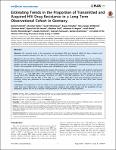Estimating Trends in the Proportion of Transmitted and Acquired HIV Drug Resistance in a Long Term Observational Cohort in Germany
Schmidt, Daniel
Kollan, Christian
Fätkenheuer, Gerd
Schülter, Eugen
Stellbrink, Hans-Jürgen
Noah, Christian
Jensen, Björn-Erik Ole
Stoll, Matthias
Bogner, Johannes R.
Eberle, Josef
Meixenberger, Karolin
Kücherer, Claudia
Hamouda, Osamah
Bartmeyer, Barbara
Objective: We assessed trends in the proportion of transmitted (TDR) and acquired (ADR) HIV drug resistance and associated mutations between 2001 and 2011 in the German ClinSurv-HIV Drug Resistance Study. Method: The German ClinSurv-HIV Drug Resistance Study is a subset of the German ClinSurv-HIV Cohort. For the ClinSurv-HIV Drug Resistance Study all available sequences isolated from patients in five study centres of the long term observational ClinSurv-HIV Cohort were included. TDR was estimated using the first viral sequence of antiretroviral treatment (ART) naïve patients. One HIV sequence/patient/year of ART experienced patients was considered to estimate the proportion of ADR. Trends in the proportion of HIV drug resistance were calculated by logistic regression. Results: 9,528 patients were included into the analysis. HIV-sequences of antiretroviral naïve and treatment experienced patients were available from 34% (3,267/9,528) of patients. The proportion of TDR over time was stable at 10.4% (95% CI 9.1–11.8; p for trend = 0.6; 2001–2011). The proportion of ADR among all treated patients was 16%, whereas it was high among those with available HIV genotypic resistance test (64%; 1,310/2,049 sequences; 95% CI 62–66) but declined significantly over time (OR 0.8; 95% CI 0.77–0.83; p for trend
No license information

